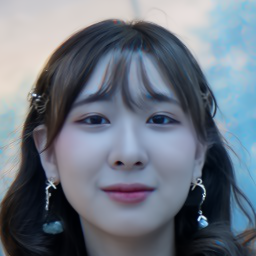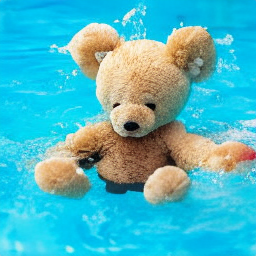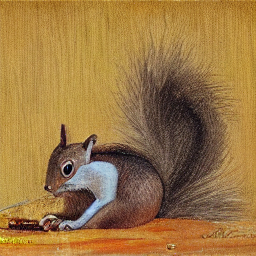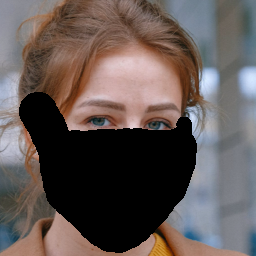diffae
Maintainer: cjwbw

15

| Property | Value |
|---|---|
| Model Link | View on Replicate |
| API Spec | View on Replicate |
| Github Link | View on Github |
| Paper Link | View on Arxiv |
Get summaries of the top AI models delivered straight to your inbox:
Model overview
diffae is an AI model for image manipulation developed by Konpat Preechakul, Nattanat Chatthee, Suttisak Wizadwongsa, and Supasorn Suwajanakorn. It is based on their research paper "Diffusion Autoencoders: Toward a Meaningful and Decodable Representation" which was presented at CVPR 2022. The model builds on Stable Diffusion by using a diffusion autoencoder to learn a more meaningful and decodable latent representation, enabling controllable image manipulation.
Model inputs and outputs
diffae takes an input image and allows for targeted manipulation along various semantic attributes, such as adding bangs, eyeglasses, or changing hairstyles. The key inputs are the original image, the target manipulation class, and the desired manipulation amplitude. The model then outputs the manipulated image.
Inputs
- image: The input image to be manipulated. The image will be aligned and cropped before processing.
- target_class: The semantic attribute to be modified, such as "Bangs", "Eyeglasses", or "Wavy Hair".
- manipulation_amplitude: The strength of the desired manipulation, from -0.5 to 0.5.
- T_step: The number of steps to use for the image generation process, with a default of 100.
- T_inv: The number of steps to use for the inversion process, with a default of 200.
Outputs
- Array of manipulated images: The model outputs an array of manipulated images, with the target attribute adjusted based on the provided inputs.
Capabilities
diffae is capable of performing high-quality, semantic-aware image manipulation on faces. Unlike simple attribute editing, diffae can seamlessly blend the target attribute with the original image, producing natural-looking results. The model has been trained on the FFHQ, Bedroom, and Horse datasets, allowing for manipulation of a variety of image types.
What can I use it for?
diffae can be a powerful tool for content creation, photo editing, and creative exploration. By enabling targeted modifications to facial attributes, the model can be used to experiment with different styles, hairstyles, or accessories on portraits and selfies. This can be useful for applications like virtual try-on, photo editing, and social media content generation.
Things to try
One interesting aspect of diffae is its ability to perform latent-space manipulation, where changes are made directly to the model's internal representation of the image. This can lead to more nuanced and seamless modifications compared to traditional image editing techniques. Users can experiment with different manipulation amplitudes to find the right balance of change and preservation of the original image.
This summary was produced with help from an AI and may contain inaccuracies - check out the links to read the original source documents!
Related Models

stable-diffusion

107.9K
Stable Diffusion is a latent text-to-image diffusion model capable of generating photo-realistic images given any text input. Developed by Stability AI, it is an impressive AI model that can create stunning visuals from simple text prompts. The model has several versions, with each newer version being trained for longer and producing higher-quality images than the previous ones. The main advantage of Stable Diffusion is its ability to generate highly detailed and realistic images from a wide range of textual descriptions. This makes it a powerful tool for creative applications, allowing users to visualize their ideas and concepts in a photorealistic way. The model has been trained on a large and diverse dataset, enabling it to handle a broad spectrum of subjects and styles. Model inputs and outputs Inputs Prompt**: The text prompt that describes the desired image. This can be a simple description or a more detailed, creative prompt. Seed**: An optional random seed value to control the randomness of the image generation process. Width and Height**: The desired dimensions of the generated image, which must be multiples of 64. Scheduler**: The algorithm used to generate the image, with options like DPMSolverMultistep. Num Outputs**: The number of images to generate (up to 4). Guidance Scale**: The scale for classifier-free guidance, which controls the trade-off between image quality and faithfulness to the input prompt. Negative Prompt**: Text that specifies things the model should avoid including in the generated image. Num Inference Steps**: The number of denoising steps to perform during the image generation process. Outputs Array of image URLs**: The generated images are returned as an array of URLs pointing to the created images. Capabilities Stable Diffusion is capable of generating a wide variety of photorealistic images from text prompts. It can create images of people, animals, landscapes, architecture, and more, with a high level of detail and accuracy. The model is particularly skilled at rendering complex scenes and capturing the essence of the input prompt. One of the key strengths of Stable Diffusion is its ability to handle diverse prompts, from simple descriptions to more creative and imaginative ideas. The model can generate images of fantastical creatures, surreal landscapes, and even abstract concepts with impressive results. What can I use it for? Stable Diffusion can be used for a variety of creative applications, such as: Visualizing ideas and concepts for art, design, or storytelling Generating images for use in marketing, advertising, or social media Aiding in the development of games, movies, or other visual media Exploring and experimenting with new ideas and artistic styles The model's versatility and high-quality output make it a valuable tool for anyone looking to bring their ideas to life through visual art. By combining the power of AI with human creativity, Stable Diffusion opens up new possibilities for visual expression and innovation. Things to try One interesting aspect of Stable Diffusion is its ability to generate images with a high level of detail and realism. Users can experiment with prompts that combine specific elements, such as "a steam-powered robot exploring a lush, alien jungle," to see how the model handles complex and imaginative scenes. Additionally, the model's support for different image sizes and resolutions allows users to explore the limits of its capabilities. By generating images at various scales, users can see how the model handles the level of detail and complexity required for different use cases, such as high-resolution artwork or smaller social media graphics. Overall, Stable Diffusion is a powerful and versatile AI model that offers endless possibilities for creative expression and exploration. By experimenting with different prompts, settings, and output formats, users can unlock the full potential of this cutting-edge text-to-image technology.
Updated Invalid Date

vq-diffusion

20
vq-diffusion is a text-to-image synthesis model developed by cjwbw. It is similar to other diffusion models like stable-diffusion, stable-diffusion-v2, latent-diffusion-text2img, clip-guided-diffusion, and van-gogh-diffusion, all of which are capable of generating photorealistic images from text prompts. The key innovation in vq-diffusion is the use of vector quantization to improve the quality and coherence of the generated images. Model inputs and outputs vq-diffusion takes in a text prompt and various parameters to control the generation process. The outputs are one or more high-quality images that match the input prompt. Inputs prompt**: The text prompt describing the desired image. image_class**: The ImageNet class label to use for generation (if generation_type is set to ImageNet class label). guidance_scale**: A value that controls the strength of the text guidance during sampling. generation_type**: Specifies whether to generate from in-the-wild text, MSCOCO datasets, or ImageNet class labels. truncation_rate**: A value between 0 and 1 that controls the amount of truncation applied during sampling. Outputs An array of generated images that match the input prompt. Capabilities vq-diffusion can generate a wide variety of photorealistic images from text prompts, spanning scenes, objects, and abstract concepts. It uses vector quantization to improve the coherence and fidelity of the generated images compared to other diffusion models. What can I use it for? vq-diffusion can be used for a variety of creative and commercial applications, such as visual art, product design, marketing, and entertainment. For example, you could use it to generate concept art for a video game, create unique product visuals for an e-commerce store, or produce promotional images for a new service or event. Things to try One interesting aspect of vq-diffusion is its ability to generate images that mix different visual styles and concepts. For example, you could try prompting it to create a "photorealistic painting of a robot in the style of Van Gogh" and see the results. Experimenting with different prompts and parameter settings can lead to some fascinating and unexpected outputs.
Updated Invalid Date

latent-diffusion-text2img

4
The latent-diffusion-text2img model is a text-to-image AI model developed by cjwbw, a creator on Replicate. It uses latent diffusion, a technique that allows for high-resolution image synthesis from text prompts. This model is similar to other text-to-image models like stable-diffusion, stable-diffusion-v2, and stable-diffusion-2-1-unclip, which are also capable of generating photo-realistic images from text. Model inputs and outputs The latent-diffusion-text2img model takes a text prompt as input and generates an image as output. The text prompt can describe a wide range of subjects, from realistic scenes to abstract concepts, and the model will attempt to generate a corresponding image. Inputs Prompt**: A text description of the desired image. Seed**: An optional seed value to enable reproducible sampling. Ddim steps**: The number of diffusion steps to use during sampling. Ddim eta**: The eta parameter for the DDIM sampler, which controls the amount of noise injected during sampling. Scale**: The unconditional guidance scale, which controls the balance between the text prompt and the model's own prior. Plms**: Whether to use the PLMS sampler instead of the default DDIM sampler. N samples**: The number of samples to generate for each prompt. Outputs Image**: A high-resolution image generated from the input text prompt. Capabilities The latent-diffusion-text2img model is capable of generating a wide variety of photo-realistic images from text prompts. It can create scenes with detailed objects, characters, and environments, as well as more abstract and surreal imagery. The model's ability to capture the essence of a text prompt and translate it into a visually compelling image makes it a powerful tool for creative expression and visual storytelling. What can I use it for? You can use the latent-diffusion-text2img model to create custom images for various applications, such as: Illustrations and artwork for books, magazines, or websites Concept art for games, films, or other media Product visualization and design Social media content and marketing assets Personal creative projects and artistic exploration The model's versatility allows you to experiment with different text prompts and see how they are interpreted visually, opening up new possibilities for artistic expression and collaboration between text and image. Things to try One interesting aspect of the latent-diffusion-text2img model is its ability to generate images that go beyond the typical 256x256 resolution. By adjusting the H and W arguments, you can instruct the model to generate larger images, up to 384x1024 or more. This can result in intriguing and unexpected visual outcomes, as the model tries to scale up the generated imagery while maintaining its coherence and detail. Another thing to try is using the model's "retrieval-augmented" mode, which allows you to condition the generation on both the text prompt and a set of related images retrieved from a database. This can help the model better understand the context and visual references associated with the prompt, potentially leading to more interesting and faithful image generation.
Updated Invalid Date

repaint

3
repaint is an AI model for inpainting, or filling in missing parts of an image, using denoising diffusion probabilistic models. It was developed by cjwbw, who has created several other notable AI models like stable-diffusion-v2-inpainting, analog-diffusion, and pastel-mix. The repaint model can fill in missing regions of an image while keeping the known parts harmonized, and can handle a variety of mask shapes and sizes, including extreme cases like every other line or large upscaling. Model inputs and outputs The repaint model takes in an input image, a mask indicating which regions are missing, and a model to use (e.g. CelebA-HQ, ImageNet, Places2). It then generates a new image with the missing regions filled in, while maintaining the integrity of the known parts. The user can also adjust the number of inference steps to control the speed vs. quality tradeoff. Inputs Image**: The input image, which is expected to be aligned for facial images. Mask**: The type of mask to apply to the image, such as random strokes, half the image, or a sparse pattern. Model**: The pre-trained model to use for inpainting, based on the content of the input image. Steps**: The number of denoising steps to perform, which affects the speed and quality of the output. Outputs Mask**: The mask used to generate the output image. Masked Image**: The input image with the mask applied. Inpaint**: The final output image with the missing regions filled in. Capabilities The repaint model can handle a wide variety of inpainting tasks, from filling in random strokes or half an image, to more extreme cases like upscaling an image or inpainting every other line. It is able to generate meaningful and harmonious fillings, incorporating details like expressions, features, and logos into the missing regions. The model outperforms state-of-the-art autoregressive and GAN-based inpainting methods in user studies across multiple datasets and mask types. What can I use it for? The repaint model could be useful for a variety of image editing and content creation tasks, such as: Repairing damaged or corrupted images Removing unwanted elements from photos (e.g. power lines, obstructions) Generating new image content to expand or modify existing images Upscaling low-resolution images while maintaining visual coherence By leveraging the power of denoising diffusion models, repaint can produce high-quality, realistic inpaintings that seamlessly blend with the known parts of the image. Things to try One interesting aspect of the repaint model is its ability to handle extreme inpainting cases, such as filling in every other line of an image or upscaling with a large mask. These challenging scenarios can showcase the model's strengths in generating coherent and meaningful fillings, even when faced with a significant amount of missing information. Another intriguing possibility is to experiment with the number of denoising steps, as this allows the user to balance the speed and quality of the inpainting. Reducing the number of steps can lead to faster inference, but may result in less harmonious fillings, while increasing the steps can improve the visual quality at the cost of longer processing times. Overall, the repaint model represents a powerful tool for image inpainting and manipulation, with the potential to unlock new creative possibilities for artists, designers, and content creators.
Updated Invalid Date